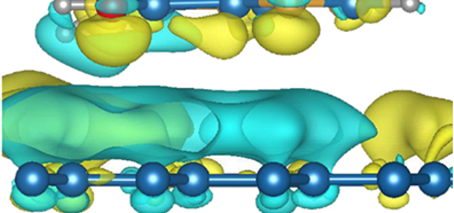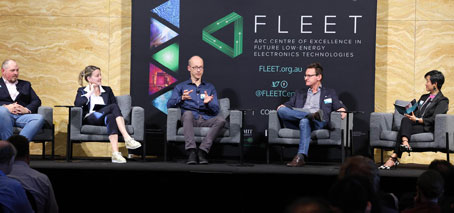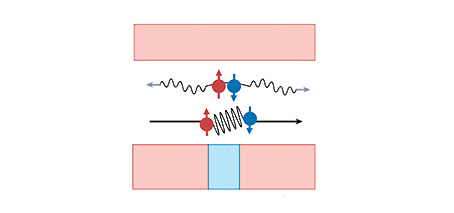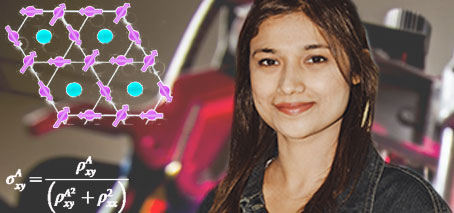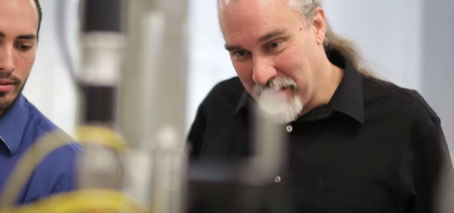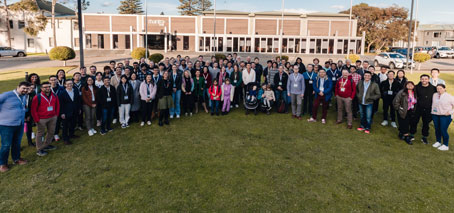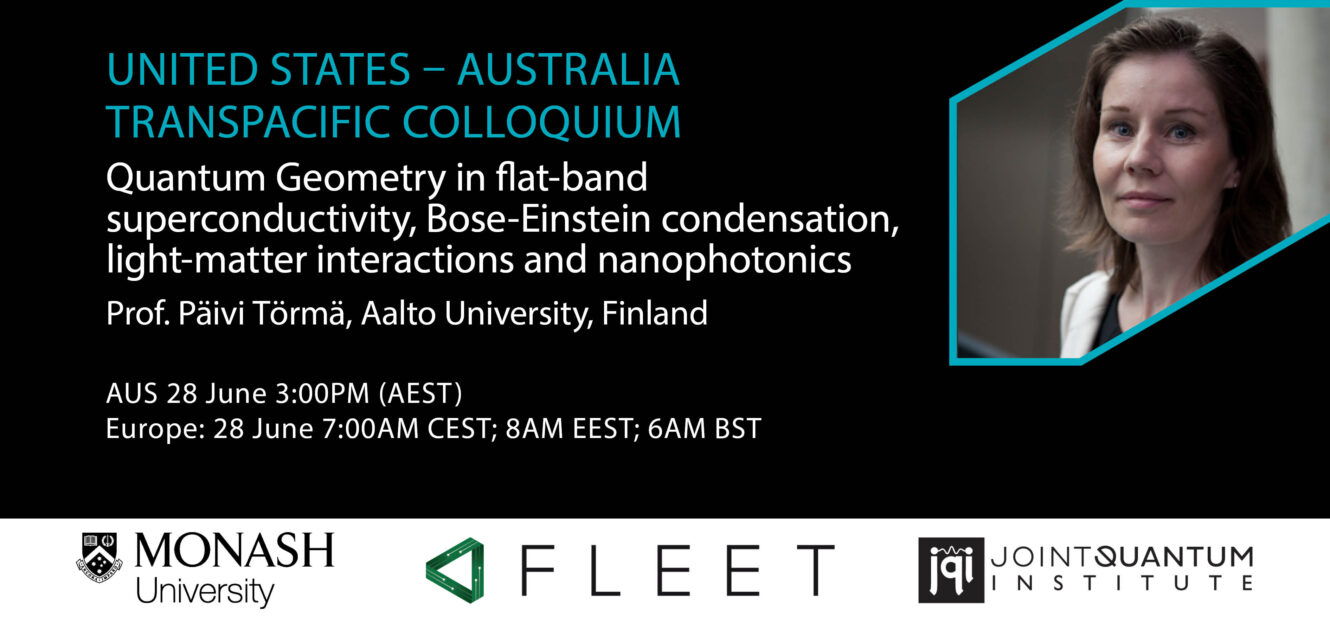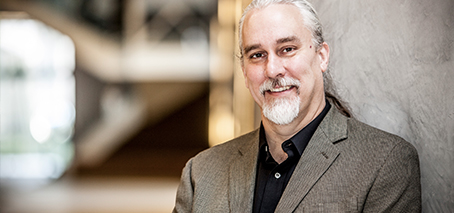There is considerable excitement about graphene-based biosensors. In particular, the material’s unique structure and electronic properties offers great potential for rapid, reliable DNA/RNA sensing and sequencing. To date, this potential has been checked by a lack of fundamental understanding of graphene−nucleobase interactions and the origin of measured molecular fingerprints. A recent study has defined key interactions as DNA/RNA nucleobases are …
UNSW: Theory of artificial graphene
We seek a postdoctoral researcher with experience in quantum condensed matter theory of interacting electrons and topological phases. This Level A/B Academic position will be supervised by Prof. Oleg Sushkov at UNSW based in Sydney. What we are looking for: The incumbent should possess a completed PhD degree, or a substantial progress towards a PhD degree, in Condensed Matter Physics, …
FLEET News
FLEET News in April 2024 includes an article on switching a metal-organic material on and off (new paper from Monash), a new ARC Pride network, Mitch Conway’s Pocket Guide to Doing a PhD, and the first leg of Sue Coppersmith’s Women in Physics tour. You can sign up for FLEET news here. Catch up on previous versions of the FLEET …
Transport Studies on Twisted Transition Metal Dichalcogenides
Making artificial electronic crystals
The electronic properties of materials are determined by the atomic constituents and their crystal lattice structure. Engineered electronic materials, which are created by applying a designed spatially periodic potential, a superlattice, have offered a powerful way to alter the properties of natural crystals in a controlled manner. Imposing spatially periodic electric field via nanolithography has also been proven to be …
Electron magneto-hydrodynamics in GaAs systems
Viscous effects in electronic systems typically arise from vorticity at the boundaries of the 2D system. This limits the contribution of the viscous dissipation to the total dissipation of the system, making the viscous effect challenging to measure. In our work, we use a periodic array of micromagnets to create vorticity – and thus viscous dissipation – across the entire …
Meet FLEET innovation-and-industry event
An audience of around 90 gathered for the Meet FLEET event at UNSW earlier this month, comprising researchers, industry representatives and others. A major aim of the event was to serve as a bridge, fostering connections while providing industry professionals and researchers the opportunity to delve into collaborative research and development programs. Meet FLEET also showcased the Centre’s research capabilities …
Optical Pump Terahertz Probe
Overview of recent exciting results on room temperature condensation of exciton-polaritons and Optical Pump Terahertz Probe (OPTP) results in graphene. About the presenter Gary Beane is a Research Fellow working with A/Prof Agustin Schiffrin at Monash University, where he is investigating optically driven topological phases of matter using terahertz time domain spectroscopy and ultrafast pump-probe spectroscopy. He is mainly involved …
Overview of THz-TDS results
I will present on recent results in our group on 1) room temperature condensation of exciton-polaritons in perovskite-DBR microcavities and 2) Broadband optical-pump THz probe (OPTP) results with graphene. About the presenter Gary Beane is a Research Fellow working with A/Prof Agustin Schiffrin at Monash University, where he is investigating optically driven topological phases of matter using terahertz time domain …
Non-Onsager Quantum Magnetic Oscillations
Oscillation effects in crystals have been studied since the 1930s, when it was observed that a metal’s magnetisation and resistance are periodic in the inverse magnetic field. Typically, the oscillation frequency corresponds to the area of a closed cross-section of the Fermi surface, these are Onsager oscillations. We show that oscillations arise, in equilibrium, which do not correspond to any …
FLEET Legacy Workshop Program
The scientific program is below, the abstract and presenter bio can be viewed by clicking on the title. The PDF of the workshop schedule can be downloaded here. Venue map Breakfast and Lunch: Novotel restaurant Registration and tea breaks: Pre-function lobby Conference: Surfers|Currumbin Poster sessions: Miami|Wavebreak Dinner: Surfers|Currumbin Creche: Kirra Executive meeting on Thursday: Burleigh Wednesday 29 Nov 2023 Poster …
Meet FLEET Program
The Meet FLEET program will highlight opportunities for Australian companies to co-develop advanced technologies into deep-tech applications that create growth and value. Opportunities exist for joint R&D programs, new product development and co-creation of IP by leveraging FLEET research expertise with your own technology development capabilities. Program Panel Discussion – Innovation agents This panel brings together key enablers of industry-academia …
The Australian Synchrotron: A materials analysis toolkit
The Challenge Development of advanced quantum technologies and devices requires a fundamental understanding of the constituent building block ‘quantum materials’ which underpin their exciting properties Quantum materials require high purity and order (structure and chemistry) Precision measurement techniques are required following growth/fabrication. The Solution The Australian Synchrotron is the southern hemisphere’s brightest source of X-rays. We provide a range of …
Examining the superconducting diode effect
A collaboration of FLEET researchers from the University of Wollongong and Monash University have reviewed the superconducting diode effect, one of the most fascinating phenomena recently discovered in quantum condensed-matter physics. A superconducting diode enables dissipationless supercurrent to flow in only one direction, and provides new functionalities for superconducting circuits. This non-dissipative circuit element is key to future ultra-low energy …
Aluminium oxides-based LED encapsulant
The Challenge Light-emitting diodes (LEDs) are consumer electronics that play a crucial role in our daily life-from a mobile phone to LED billboards, LEDs are ubiquitous. There are, however, delicate components sitting inside each LED unit that need to be protected in a dry and oxygen free environment. The lifespan of typical LEDs …
Alumni profile: Quantum materials researcher Wafa Afzal
A note from previous FLEET PhD candidate Dr. Wafa Afzal, still researching novel materials, now at Archer Materials I was a PhD student at FLEET, based at the University of Wollongong under the supervision of Prof. Xiaolin Wang, studying the electrical and magnetic properties of topological Weyl semimetals. I’m still researching novel materials, now in the Quantum team at Archer …
Science Academy video: Prof Michael Fuhrer FAA
Here’s the problem: the more we use computers, the more energy that’s required. Driven by a deep intellectual curiosity, Prof Fuhrer (Monash University) was drawn to science at an early age and now has a passion for mentoring the next generation of scientists, teaching them how it pays to be patient. New video out from the Australian Academy of Science, …
FLEET2023 annual workshop in Lorne
Just under 120 members, family and affiliates gathered in Lorne Victoria this month for FLEET’s 2023 annual workshop, which featured 35 scientific talks (over 60% of them by ECRs), 30 accompanying family (17 kids), a cultural celebration dinner, karaoke, quiz, lawn bowls, and lots of unstructured time for collaborative discussions. Invited presentations included: Nicola Gaston, MacDiarmid Institute Mateusz Król, Warsaw …
Inhomogeneous Friction Behaviour of Nanoscale Phase Separated Layered CuInP2S6
Mechanical friction leads to wear and energy dissipation, and its control is of high importance in new-generation miniature electromechanical devices. 2D materials such as graphene are considered to be excellent solid lubricants due to their ultralow friction and have attracted considerable research interest. Unique friction properties are discovered in various other 2D materials. However, the friction of functional van der …
US-Europe-AUST Colloqium. Quantum Geometry in flat-band superconductivity, Bose-Einstein condensation, light-matter interactions and nanophotonics
Päivi Törmä, Department of Applied Physics, Aalto University, Finland Catch up on YouTube We have found that superconductivity and superfluidity have a connection to quantum geometry [1,2]. Namely, the superfluid weight in a multiband system has a previously unnoticed component which we call the geometric contribution. It is proportional to the minimal quantum metric of the band. Quantum metric is …
In-situ epitaxial aluminium gates in ultra-shallow GaAs heterostructures for low noise quantum point contacts
Using metal gates deposited in the wafer growth chamber reduces scattering from charge at the wafer surface, enhancing electron mobility and decreasing charge noise. This makes in situ grown gates ideal for a myriad of systems, from artificial lattices to quantum electronic devices such as quantum point contacts, quantum dots and quantum bits. About the presenter Yonatan Ashlea Alava is …
Hydrodynamics in 2DEG density interfaces
Recent advancement in fabrication of ultra-clean samples (in graphene and in semiconductor heterojunctions [1]) has led to the realisation of a new regime of electron transport previously unexplored, i.e, the hydrodynamic regime. In this work, the implications of hydrodynamic transport through interfaces with varying density profiles in 2DEGs are explored, as well as possible experimental realisation is discussed. [1] A. …
Cold neutrons as a probe of quantum matter
In this poster I will review how cold neutrons can be used to detect the phonons, magnons and magnetic structure of quantum materials. As an example I will present measurements of the phonon bandstructure in graphene and Bi2Te3. I will discuss the upcoming upgrade to the ANSTO cold neutron source scheduled for 2024. About the presenter David Cortie is a …
New kind of magnetic oscillation in artificial crystals
Recent experiments on two-dimensional artificial crystals have revealed a set of magnetic oscillations with unexpected frequencies. We present a theory of these oscillations and show that they are of a kind not previously observed in artificial crystals or in real metals. In particular, we show that they arise from open electron trajectories. About the presenter Zeb Krix is a Research …
Bandgap and Exciton Energy Renormalization in Doped TMD
About the presenter Jack is a PhD candidate in CI Oleg Sushkov‘s group. His project aims to establish a theoretical groundwork for magnetohydrodynamics in 2D electron fluids using periodic micromagnets. This work fits the FLEET Enabling Research Theme 1, Topological Materials.
FLEET Director elected Fellow of the Australian Academy of Science
Leading materials physicist and FLEET Director Prof Michael Fuhrer has been recognised for his contributions to science, elected a Fellow of the Australian Academy of Science. Professor Fuhrer is one of 20 researchers elected as Fellow of the Australian Academy of Science, announced today. Prof Michael Fuhrer is an international leader in study of the electronic properties of 2D and …
FLEET 2023 Workshop Program
The scientific program is below, the abstract and presenter bio can be viewed by clicking on the title. The PDF of the workshop schedule can be downloaded here. Monday 3 July Tuesday 4 July Poster Session Tuesday 4 July Wednesday 5 July Poster Session Wednesday 5 July Vote for your favourite poster Three $200 cash prizes for the three best posters – …
Annual Workshop 2023
Monday 3 July Tuesday 4 July Wednesday 5 July Thursday 6 July Friday 7 July
US-Australia condensed-matter/cold atoms colloquia series
UNSW seminar: Topology and transport in interacting electron systems
Prof Thomas Schmidt, University of Luxembourg, Friday 5 May 2023 at the UNSW Physics building Coulomb interactions between electrons can give rise to a plethora of novel phenomena in solid-state systems. In this talk I will focus on two phenomena which are caused by the interplay of interactions and band topology in two-dimensional electron systems. In the semiclassical regime, electron …

